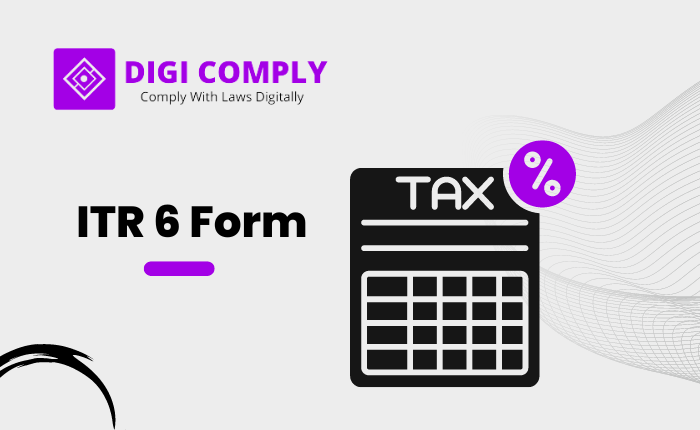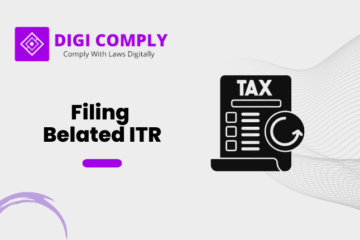Tax filing season is an annual ritual for businesses across the globe. In India, the Income Tax Return (ITR) form plays a crucial role in the process, enabling businesses to report their income, deductions, and tax liability accurately. Among the various ITR forms, ITR-6 is specifically designed for companies other than those claiming exemptions under Section 11 of the Income Tax Act. In this blog post, we will explore the ITR-6 form in detail, guiding you through the essentials of filing your business income tax return seamlessly.
Understanding ITR-6 Form:
ITR-6 is an income tax return form applicable to companies, including those that are not eligible for exemptions under Section 11. It covers domestic companies, excluding those classified as limited liability partnerships (LLPs), firms, cooperative societies, and associations. ITR-6 serves as a comprehensive document that captures the financial details of the business, including income, expenses, deductions, and taxes paid.
Which entities are required to file ITR 6?
ITR 6 Form must be filed by all companies that are registered under the Companies Act 2013 or the earlier Companies Act 1956. However, companies that derive their income solely from properties held for religious or charitable purposes are exempted from the obligation to file ITR 6 Form.
ITR 6 is structured into two main parts, Part A and Part B, each consisting of subsections and multiple schedules that contain essential information pertaining to the taxpayer’s income and tax. Now, let’s delve into a comprehensive examination of these sections.
Part A (and its subsections):
General Information: In this subsection, the taxpayer is required to provide fundamental details about their entity, including its name, PAN number, address, CIN, incorporation date, and other relevant information.
Trading Account: This sub-section necessitates the disclosure of details regarding the company’s income and expenditure.
Balance Sheet: Within this subsection, the taxpayer is expected to provide a comprehensive breakdown of the company’s balance sheet, including liabilities, current liabilities, share capital, and other relevant financial information.
Manufacturing Account: In this subsection, the taxpayer must present figures related to the manufacturing process, such as the opening stock, closing stock, and the cost of goods produced.
Profit and Loss Account: This subsection mandates the inclusion of information regarding the company’s profits or losses incurred during the relevant financial year.
Part B (and its subsections):
Part B-TI: Computation of Total Income
Part B-TTI: Computation of Tax Liability of the Total Income.
Schedules: Purpose
1. Bank Account Details
2. Schedule –HP: Used for computing income under the head “Income from House Property.”
3. Schedule –BP: Used for computing income under the head “Profit and Gains from Business and Profession.”
4. Schedule –DPM: Used for calculating depreciation on plant and machinery.
5. Schedule –DOA: Provides a summary of depreciation on all assets.
6. Schedule –DCG: Used for calculating the deemed capital gain on the sale of depreciable assets.
7. Schedule –ESR: Deductions under Section 35 for expenditure on scientific research.
8. Schedule –CG: Used for calculating income under the head “Capital Gains.”
9. Schedule –OS: Used for calculating income from other sources.
10. Schedule –CYLA: Calculates the income after setting off the current year’s loss.
11. Schedule –BFLA: Calculation of income after setting off the unabsorbed loss from the previous year.
12. Schedule –CFL: Provides a statement of loss for carrying forward to subsequent years.
13. Schedule –UD: Presents statements of unabsorbed depreciation and allowance.
14. Schedule –ICDS: Deals with income computation disclosure standards on profit.
15. Schedule –10AA: Deductions under Section 10AA.
16. Schedule –80G: Details deductions under Section 80G relating to donations.
17. Schedule –80 GGA: Provides a statement of donations for scientific research and rural development.
18. Schedule –VIA: Presents a statement of deductions from total income under Chapter VI-A.
19. Schedule –SI: Contains details of income chargeable at special tax rates.
20. Schedule –PTI: Details relating to passing through income from a business trust or investment fund.
21. Schedule –EI: Presents a statement of exempted incomes.
22. Schedule –MAT: Provides details of tax payable under Section 115JB (Minimum Alternate Tax).
23. Schedule –DDT: Statement of tax paid on dividends, i.e., “dividend distribution tax.”
24. Schedule –BBS: Contains details of tax distributed income on buyback of shares.
25. Schedule –ESI: Provides a statement of foreign incomes and tax relief associated with them.
26. Schedule –IT: Details on advance tax paid and self-assessment tax.
27. Schedule –TDS: Contains details of TDS on incomes other than salaries.
28. Schedule –TCS: Presents a statement of TCS (Tax Collected at Source).
29. Schedule –FSI: Provides a statement of income accruing outside India.
30. Schedule –TR: Contains details of tax relief claimed for foreign tax paid.
31. Schedule –FA: Offers complete details of foreign assets and foreign income.
32. Schedule –SH1: Details of shareholding in an unlisted company.
33. Schedule –SH2: Details of shareholding in startups.
34. Schedule –AL1: Statement of assets and liabilities at the end of the year.
35. Schedule –GST: Statement of turnover reported for GST.
36. Schedule –FD: Details of payments/receipts made in foreign currency.
E-filing audit reports
In the case where the taxpayer is required to undergo an audit as per section 44AB and their accounts have been audited by a qualified accountant, it is mandatory to provide the relevant information regarding the audit report, including the details of the auditor and the date of electronically submitting the report to the concerned department.
Which entities are eligible to submit the ITR 6 Form?
The ITR 6 Form is applicable to all companies, regardless of their structure, that are registered under the Companies Act 2013 or the earlier Companies Act 1956. However, companies whose income is derived from property held for religious or charitable purposes are not obligated to file the ITR 6 Form.
Entities that have sales, turnover, or gross receipts exceeding Rs.1 crore in the previous financial year must have their accounts audited by a certified Chartered Accountant.
Who is not qualified to file the ITR 6 Form?
Companies that generate income from religious or charitable organizations can claim an exemption under Section 11. In simpler terms, an entity seeking exemption under Section 11 should refrain from filing the ITR 6 Form.
If You have any queries then connect with us at support@legalsuvidha.com or info@digicomply.in & contact us & stay updated with our latest blogs & articles





